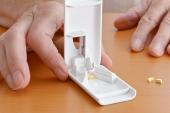AnchorMan LAAO Device Matches Up Well With the Watchman
Both devices yielded high success rates, but the use of catheter ablation alongside LAAO left some observers puzzled.

PARIS, France—A novel left atrial appendage occlusion (LAAO) device, the AnchorMan (MicroPort), has provided results similar to those seen with the Watchman (Boston Scientific) in the SAFE PROTECT trial, in which most patients underwent both LAAO and catheter ablation for atrial fibrillation (AF).
The rate of clinical success at 12 months (freedom from stroke, systemic embolism, and cardiovascular/unexplained death) was 98.1% with both devices, establishing noninferiority for the AnchorMan, Ben He, MD, PhD (Shanghai Chest Hospital, Shanghai Jiao Tong University, China), reported here at EuroPCR 2023.
The two devices also lined up well in terms of the powered secondary endpoint of LAAO (residual jet < 5 mm) at 1 year, achieved in 100% of cases during the trial. There was a difference in the sizes of the residual leaks, however, with AnchorMan-treated patients being less likely than those treated with the Watchman to have a jet of 3 to 5 mm (5.7% vs 15.9%) at follow-up.
Safety events were infrequent in both groups.
Overall, He said, “the AnchorMan LAA closure device was noninferior with respect to safety and effectiveness in nonvalvular atrial fibrillation patients compared to the Watchman LAA closure devices.”
The SAFE PROTECT Trial
SAFE PROTECT, performed across 16 centers in China, was designed to meet approval requirements of the Chinese National Medical Products Administration (NMPA). When it began enrolling, the Watchman was the only LAAO device approved by both the US Food and Drug Administration and the NMPA.
Investigators enrolled 211 patients (mean age about 68 years; 57% men) who had nonvalvular AF and a high ischemic stroke risk, meaning they had a CHA2DS2-VASc score of at least 2 for men and 3 for women and met any of the following criteria: a history of bleeding more than 6 months prior to enrollment, intolerance to long-term anticoagulant therapy, the occurrence of stroke or embolic events despite standard anticoagulation, or a HAS-BLED score of at least 3.
Roughly 40% of participants had a prior history of stroke and two-thirds were either unable to tolerate long-term anticoagulation or refused it.
Of note, procedures for 72% of patients involved a combination of AF ablation and LAA closure.
The occluders were successfully released on the first attempt in 91.6% of AnchorMan cases and 88.5% of Watchman cases. About nine out of every 10 patients in both groups had a residual jet of 3 mm or less on postprocedural transesophageal echocardiography (TEE).
Intraoperative complications were uncommon, with just three in the AnchorMan group and two in the Watchman group. There were low numbers of cerebrovascular events (2.9% vs 1.9%), pericardial effusion (1.0% vs 1.9%), and device-related complications (1.0% vs 0.9%).
At 12 months, the clinical success rate was high in both groups, with a between-group difference of -0.3% (95% CI -3.9%-3.5%). The AnchorMan was noninferior to the Watchman, with a noninferiority margin of 7%.
There were no differences between groups for any of the components of the composite outcome. One stroke and one CV/unexplained death were observed in the AnchorMan group, with two strokes and no CV/unexplained deaths in the Watchman group. Rates of all-cause death, BARC 3-5 bleeding, TIA, device-related complications, and device-related thrombus were similar in both arms of the trial.
High Rate of Combined Procedures a Limitation
Commenting for TCTMD, Christian Ukena, MD (Saarland University Medical Center, Homburg/Saar, Germany), a panelist at the late-breaking session at which He presented the results, complimented the achieved success rate and said the trial shows the AnchorMan is safe.
But he said the fact that such a high proportion of patients had combined AF ablation and LAAO was unusual. “That’s not standard of practice, not in the [electrophysiology] world and not in the interventional world,” Ukena said. Both procedures can cause complications, so even though overall complication rates were low in this study, it’s difficult to distinguish what was related to ablation and what was related to LAAO, he said.
Dirk Westermann, MD (University Heart Center Freiburg, Bad Krozingen, Germany), another panelist, said the clinical success rates of 98.1% were “incredibly high,” noting that the early trials of the Watchman had rates of 90% to 95%.
But he also indicated that additional research will be needed to establish the safety of the new device, pointing to the low numbers of patients for a noninferiority trial (with not all undergoing the 1-year TEE). “After 1 year, with just 100 patients per group with a low risk of complications due to the high experience of the centers, I think we need more data for that,” Westermann said.
The difference in peridevice leak between the two devices at 1 year also came up during the panel discussion, and He said it was difficult to explain. It’s perhaps related to edema resulting from the ablation procedure, he speculated, adding that it’s hard to say whether it’s due to better performance of the AnchorMan device itself.
Todd Neale is the Associate News Editor for TCTMD and a Senior Medical Journalist. He got his start in journalism at …
Read Full BioSources
He B. 12-month outcomes of the randomized controlled trial of the AnchorMan left atrial appendage occluder in patients at high risk of ischemic stroke with nonvalvular atrial fibrillation: SAFE PROTECT trial. Presented at: EuroPCR 2023. May 17, 2023. Paris, France.
Disclosures
- SAFE PROTECT is sponsored by MicroPort.
- He reports receiving grants/research support from MicroPort.
- Ukena reports grants/research support from Medtronic and ReCor Medical.
- Westermann reports honoraria/consulting fees from Abiomed.





Comments